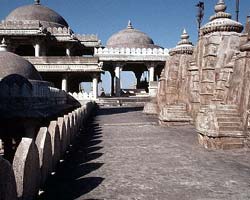 |
| Ranakpur Jain Temples |
In the early centuries of the Christian Era, the Jains (like their Buddhist counterparts) constructed stupas adorned with railings, gateways with carved figures and pillars. The image of a Tirthankara (ford maker, one of the 24 teachers of Jainism) from Lohanipur (Patna) dating back to the Mauryan period is one of the earliest Jaina figures. The Hathigumpha cave of Kharvela (with its famous inscription) and the Khandagiri and Udaigiri caves of the state of Orissa contain early Jaina relics.
During the Kushana period Mathura was a great centre of Jaina art. A votive plaque (ayapatta) depicting the cross-legged naked figure of a Tirthankara is really wonderful. The practice of making Jaina images continued throughout the Gupta period and afterwards. The gigantic statues of Bahubali (called Gometashvara) at Sharvana Belgola and Karkalla, both in Karnataka are real wonders.
Located in Pudukottai district of Tamil Nadu, Sittanavasal Cave is home to some of the best cave paintings of India. Sittanavasal is distorted form of Siddhanivasan meaning abode of Siddhas saints. An inscription written in Brahmi script and belonging to 3rd century BC has been found here. According to the inscription, these cave temples were constructed by Jain monks. The Paintings of tehe cave temples were made in frescoe technique.
The Jain temples were constructed at all places of pilgrimage. The Temples at Ranakpur, near Jodhpur in Rajasthan and the Dilwara temples at Mount Abu in the state of Rajasthan are the products of superb craftsmanship.
The Jain tower in the fort of Chittor in Rajasthan is another specimen of architectural engineering. Innumerable manuscripts in palm leaves were written down and some of them were painted with gold dust. These have given rise to a new school of painting known as the “Western Indian School’
The Jainism has played a very significant role in the development of language, philosophy, architecture, sculpture and painting in India. It never became a dominant religion, nor was it embraced by a large number of people, and it never crossed the frontiers of India, but its presence in Indian art and culture was always felt and admired. The same is true to this day.
Comments
Post a Comment